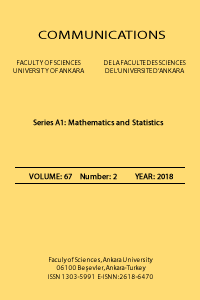A discrete time model for epidemic spread: traveling waves and spreading speeds
___
- Allen, L. J. S. Some discrete-time SI, SIR, and SIS epidemic models. Math. Biosci. (1994), (1), 83-105.
- Allen, L. J. S. ; Burgin, A.M. Comparison of deterministic and stochastic SIS and SIR models in discrete time. Math. Biosci. (2000), 163(1), 1-33.
- Aronson, D. G. The asymptotic speed of propagation of a simple epidemic. In Nonlinear Diğ usion ; Fitzgibbon, W. E., Walker, H. F., Eds.; Pittman: London, UK, 1977; pp. 1-23.
- Atkinson, C.; Reuter, G.E.H. Deterministic epidemic waves. Math. Proc. Camb. Philos. Soc. (1976), 80(2), 315-330.
- Aydogmus, O. On extinction time of a generalized endemic chain-binomial model. Math. Biosci. (2016), 276, 38-42.
- Demirci, E.,Unal, A., Ozalp , N., A fractional order SEIR model with density dependent death rate, HJMS, (2011), 40, No. 2 287–295
- Jacquez, J. A. A note on chain-binomial models of epidemic spread: What is wrong with the Reed-Frost formulation?. Math. Biosci. (1987), 87(1), 73-82.
- Kendall D.G. Mathematical models for the spread of infection. In Mathematics and Computer Science in Biology and Medicine (1965) pp. 213-225.
- Kot, M. Discrete-time travelling waves: ecological examples. J. Math. Bio. (1992), 30.4, 436.
- Li, B.; Weinberger, H. F.; Lewis, M. A. Spreading speeds as slowest wave speeds for cooper- ative systems. Math. Biosci. (2005), 196.1 82-98.
- Longini, I. M. A chain binomial model of endemicity. Math. Biosci. (1980), 50.1, 85-93.
- Lui, R. Biological growth and spread modeled by systems of recursions. I. Mathematical theory. Math. Biosci. (1989), 93.2, 269-295.
- Medlock, J. and Kot, M., Spreading disease: integro-diğerential equations old and new, Math. Biosci. (2003), 184.2, 201-222.
- Mollison, D. Spatial contact models for ecological and epidemic spread. J. Roy. Stat. Soc. B (1977), 283-326.
- Ozalp, N. and Demirci E., A fractional order SEIR model with vertical transmission, Math. and Comp. Mod. (2011), 54(1-2), 1-6.
- Precup, R., Methods in nonlinear integral equations, Springer Science & Business Media, Rass, L.; Radcliğe, J., Spatial deterministic epidemics, American Mathematical Soc. Vol. , 2003.
- Tan W.Y., Stochastic models with applications to genetics, cancers, AIDS and other biomed- ical systems, World Scienti…c Vol. 4., 2002.
- Weinberger, H. F., Long-time behavior of a class of biological models. SIAM J. Math. Anal., 3, (1982), 353-396.
- Weinberger, H. F., Some deterministic models for the spread of genetic and other alterations. In Biological Growth and Spread, Springer, 1980; 320-349.
- Current address : Ozgur Aydogmus: Department of Economics, Social Sciences University of Ankara. E-mail address : ozgur.aydogmus@asbu.edu.tr
- ISSN: 1303-5991
- Yayın Aralığı: Yılda 4 Sayı
- Başlangıç: 1948
- Yayıncı: Ankara Üniversitesi
Hüseyin BUDAK, Mehmet Zeki SARIKAYA
ON THE SECOND ORDER INVOLUTE CURVES IN E3
Şeyda KILIÇOĞLU, Süleyman ŞENYURT
Bülent ALTUNKAYA, Ferdag KAHRAMAN AKSOYAK
Shyamapada MODAK, Monirul ISLAM MD.
STATISTICAL CONVERGENCE OF MODIFIED q-DURRMEYER OPERATORS
Vishnu NARAYAN MISHRA, Prashantkumar PATEL
Safeer Hussain KHAN, Mujahid ABBAS
